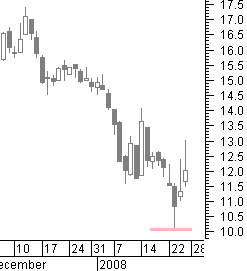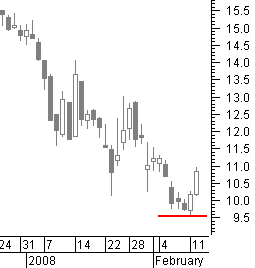TRADING STRATEGIES
Stops And More Stops
Using Initial And Trailing Stops
In this first of a three-part series, we will look at initial stop methods and compare trailing-stop strategies starting with a fixed-percentage trailing stop.
Most people have no problem buying a stock, but selling it is another matter. Selling is best accomplished based on technical analysis signals reaching a price target, breaking a trend, money management, or whatever rules you apply for trading the stock market. But you must also consider a last warning signal. This warning is an initial stop and a trailing-stop signal.
In this series of three articles, we will look at initial stop methods and compare trailing-stop methods using a fixed- percentage trailing stop, an average true range (Atr) trailing stop, a modified Atr trailing stop, and Tr&nds (read Trends), a “trailing resistance and support” stop.
Initial stop
The initial stop is set when you open your trade. When this stop level is broken, it is the ultimate and last warning sign to close your position. Setting the initial stop requires applying technical analysis basics and risk/reward ratio. Here are a few examples.
In the daily chart of Allis Chalmers (Aly) in Figure 1, you see a significant short-term correction, one that would make you consider opening a trade. But where would you set the initial stop? There is a positive confirmed bullish harami pattern in the candlestick chart.

Figure 1: significant short-term correction. Would you enter a trade at $12.02 with a stop at $10.12 for a 20% loss? In addition, note that the first target is at $14, giving you a risk/reward ratio of slightly over 1.
Logically, you would use the bottom level of the bullish harami pattern and consider the support level broken when the closing price falls below this line. This means buying now at a closing price of $12.02 and setting a stop at $10.12 or a loss of about 20%. If you are like me, you probably wouldn’t like the idea that this trade may result in a 20% loss. The first resistance for a further up move is at $14, which is a last top in the previous downtrend. Buying at $12.02 with a stop at $10.12 and a first price target at $14 gives you a risk/reward ratio of not much more than 1, which is not attractive. There should be at minimum a ratio of 2:1, but 3:1 is preferred. This is the main reason why I would not open a trade here. There are more technical reasons why I would not take this trade, but I am just going to look at the use of stops.
In Figure 2, you see the same stock a couple of weeks later. If you were to buy at the closing price of $10.85 and place a stop at the low of the bullish engulfing candle pattern at $9.56, it would limit your loss to about 12%. Technically, you have a nice confirmed bullish engulfing candlestick pattern that already closed the resistance of a previous window. With first price targets at $13 and $14, you also have an acceptable risk/reward ratio. This looks like a much better starting point to open a trade.

Figure 2: patience is virtue. By waiting a couple of weeks, your possible loss decreased to 12% with an acceptable risk/reward ratio.